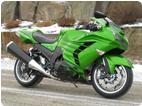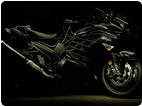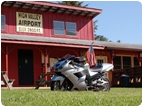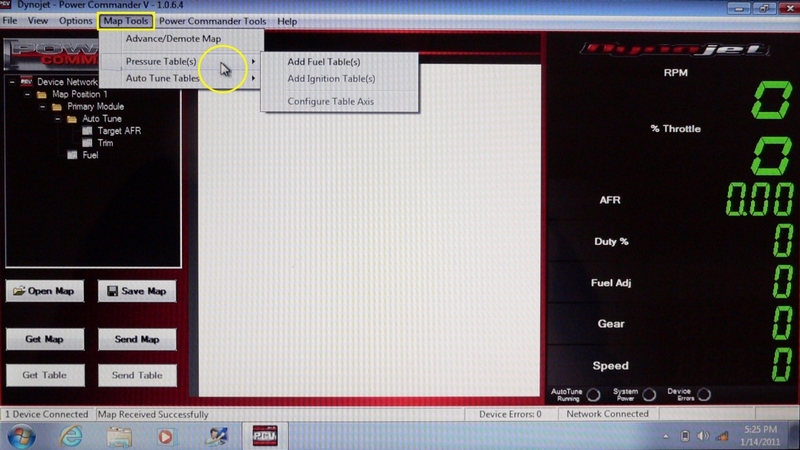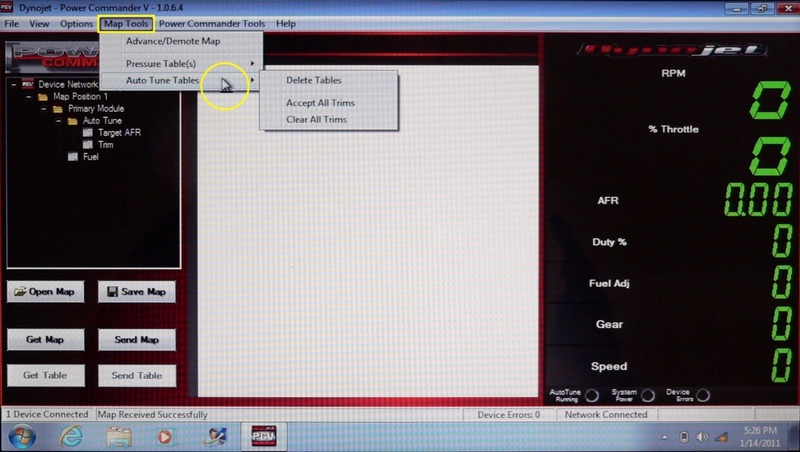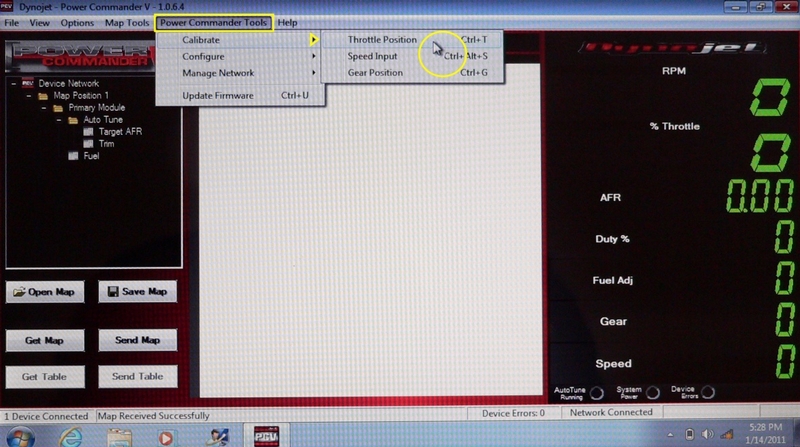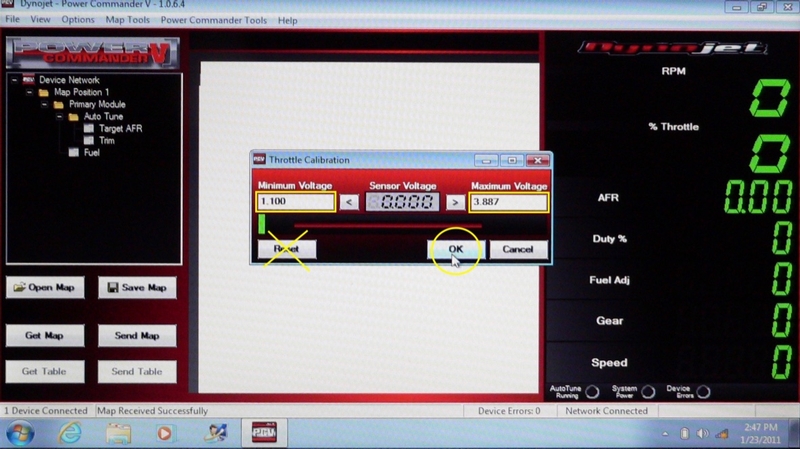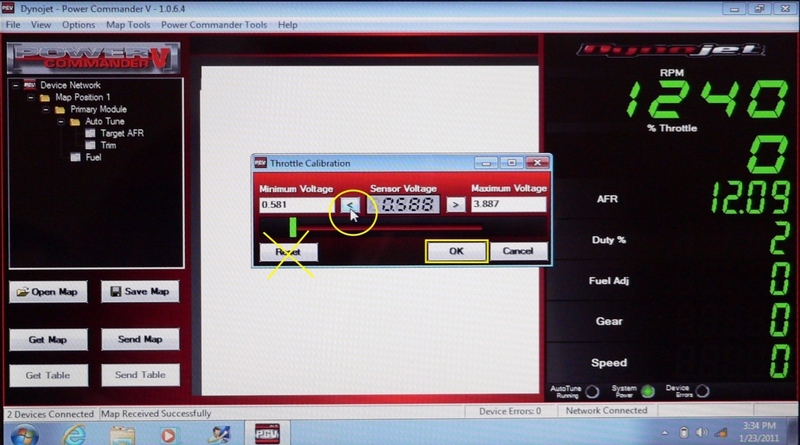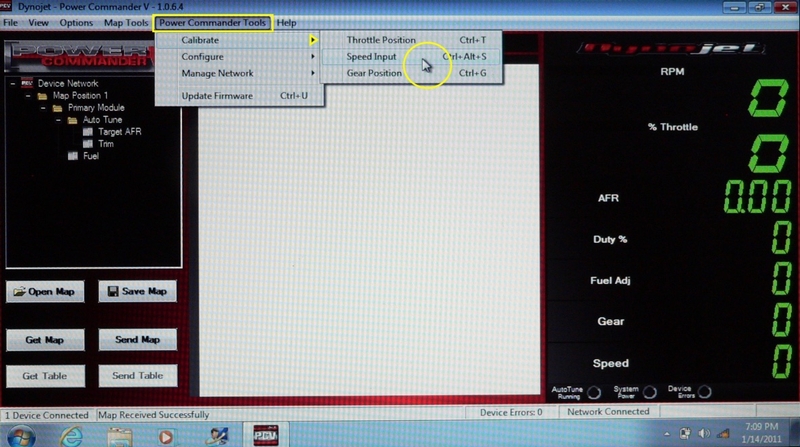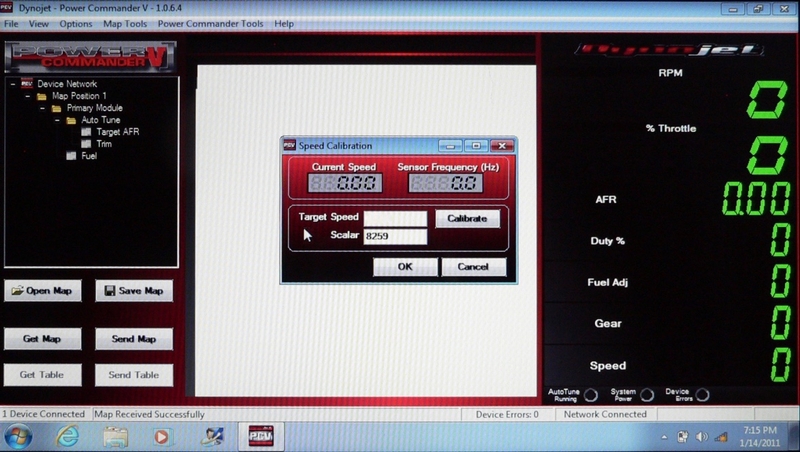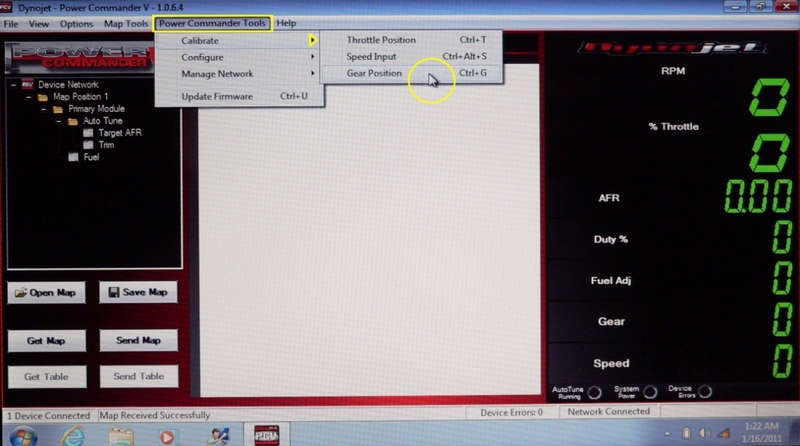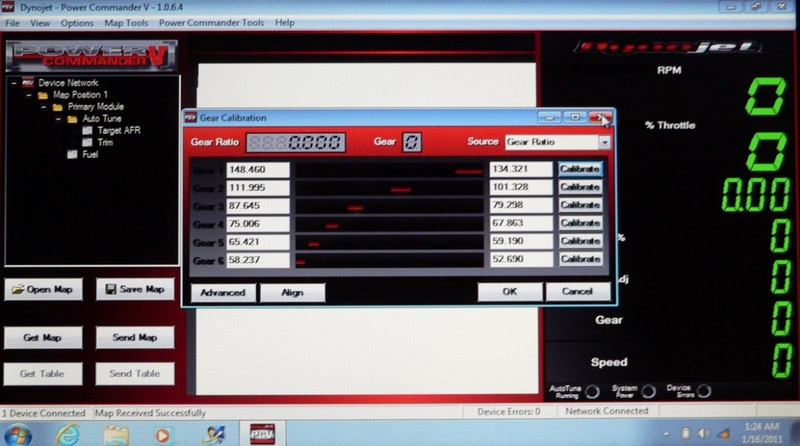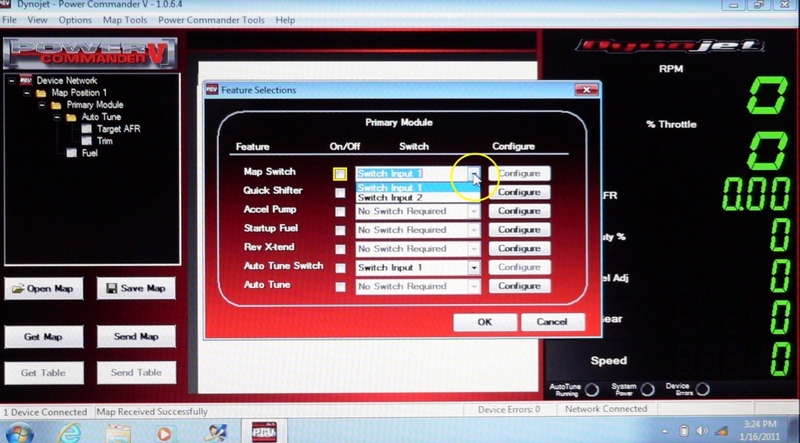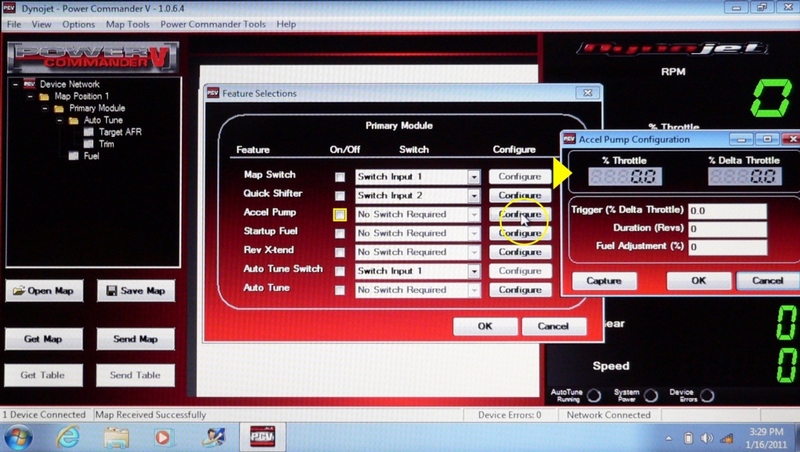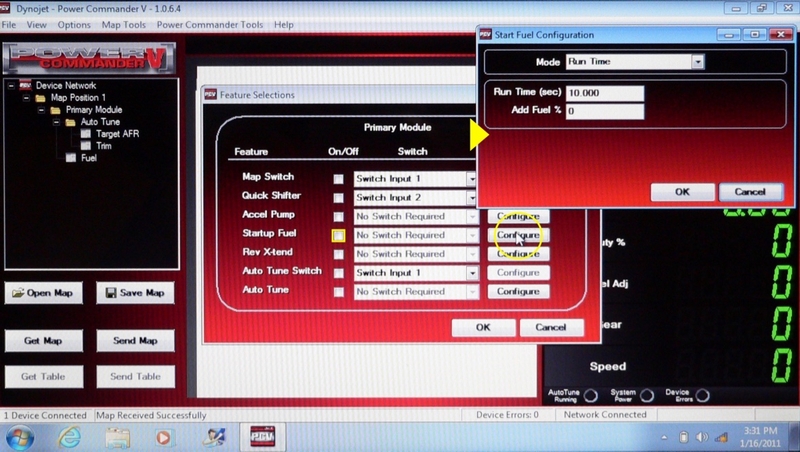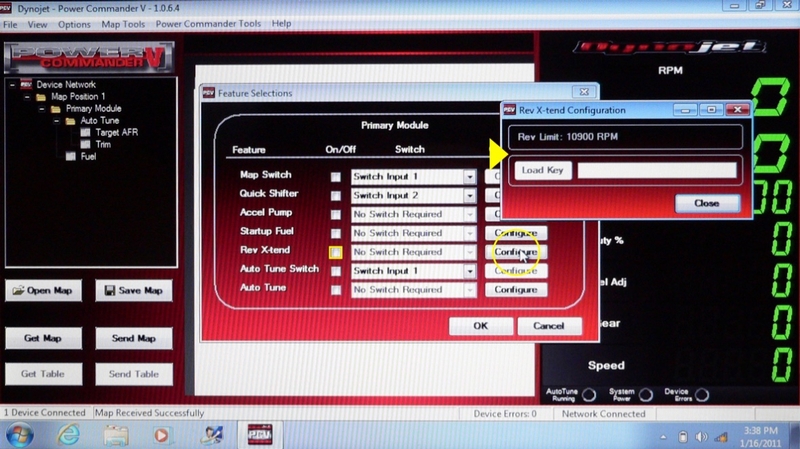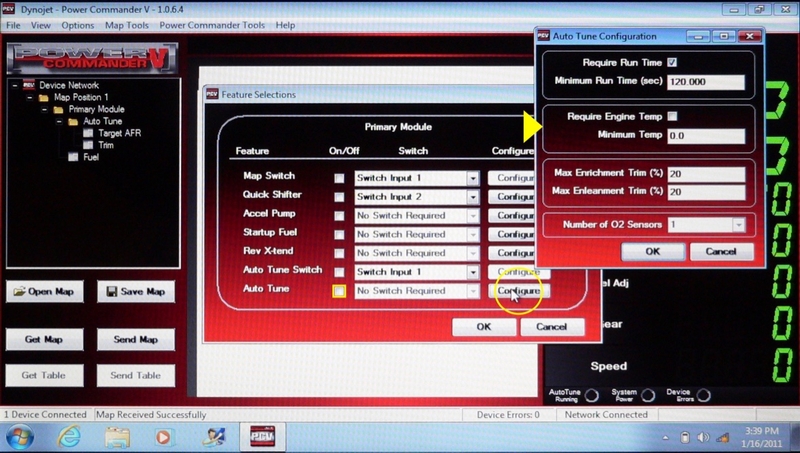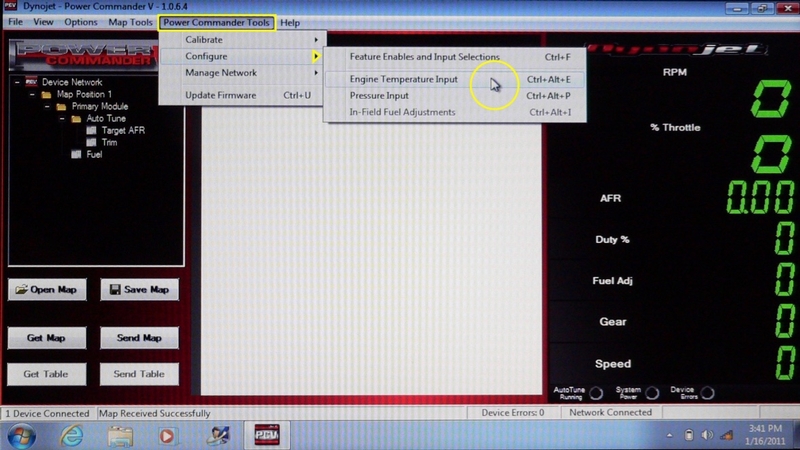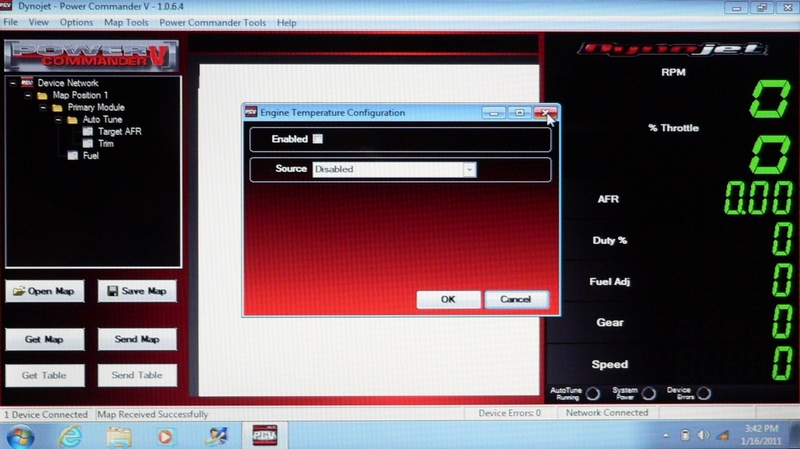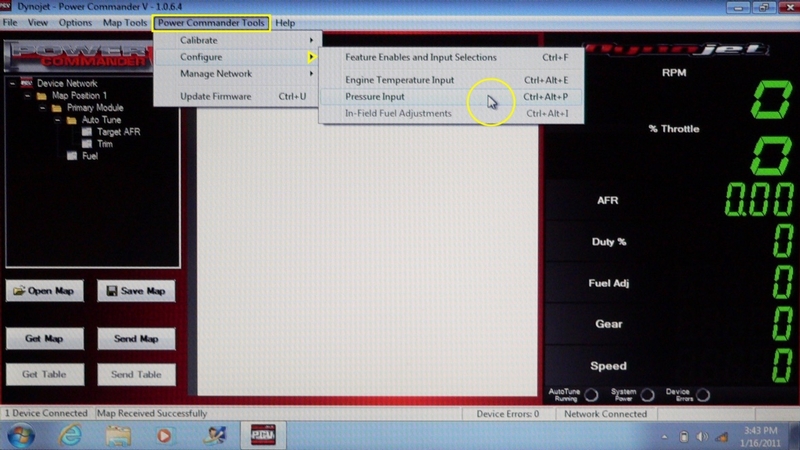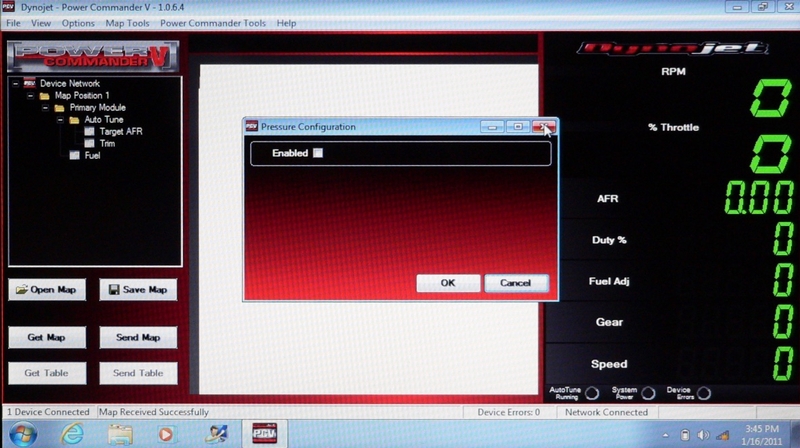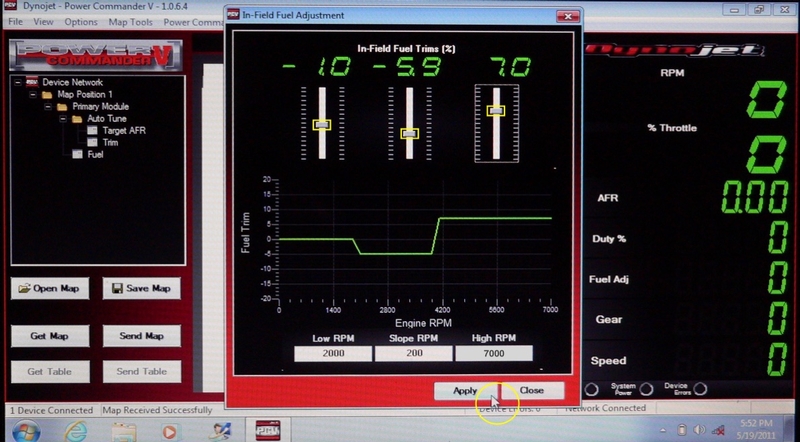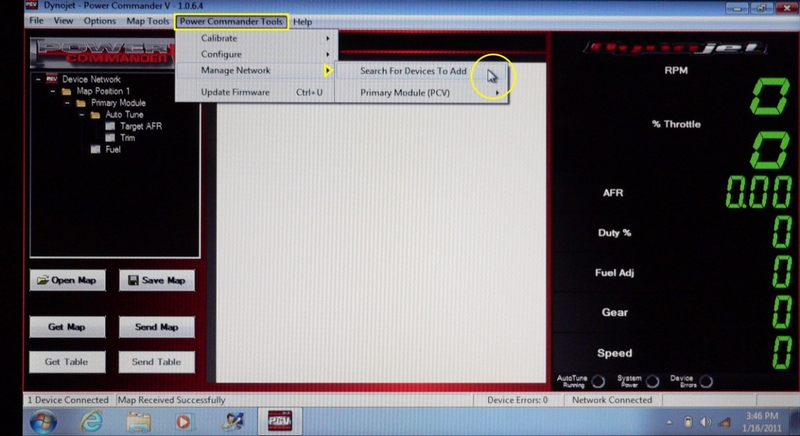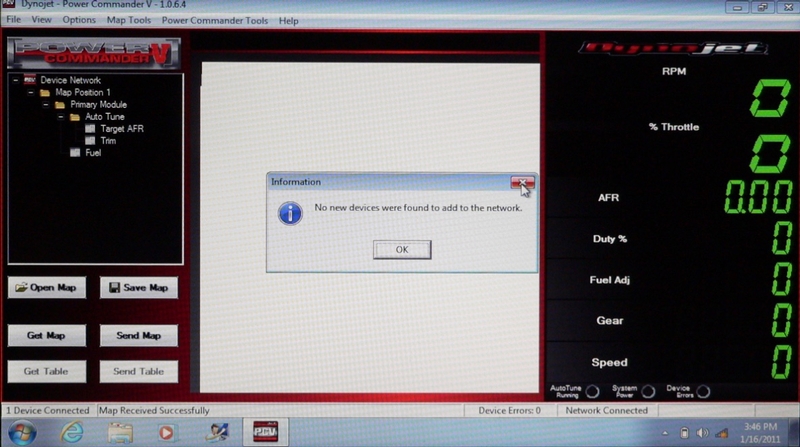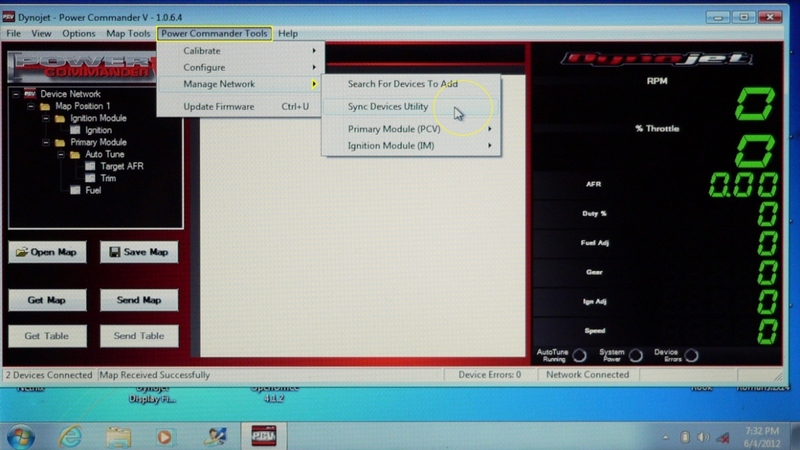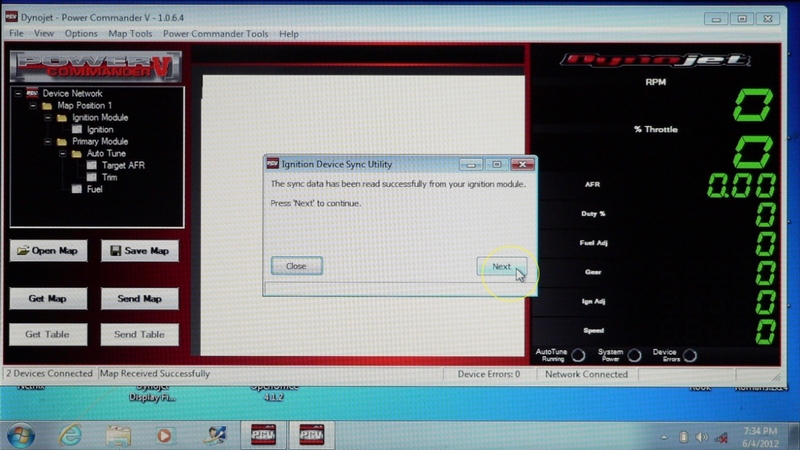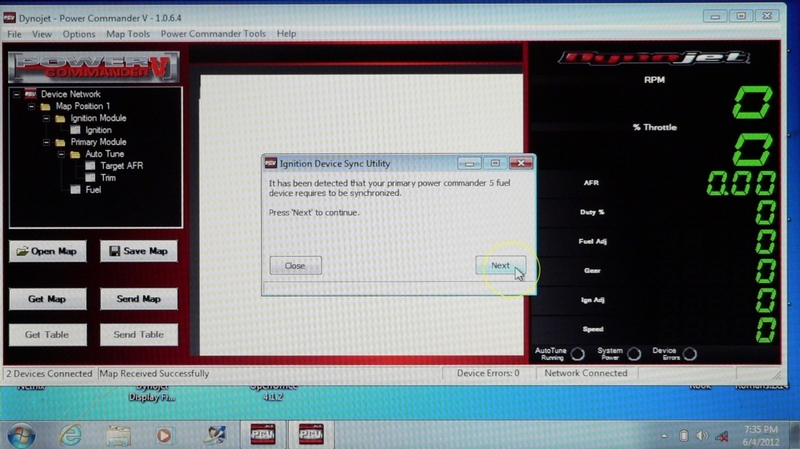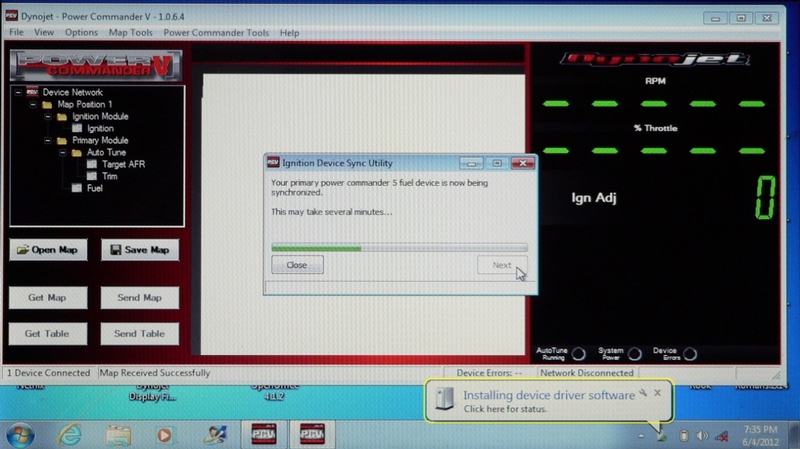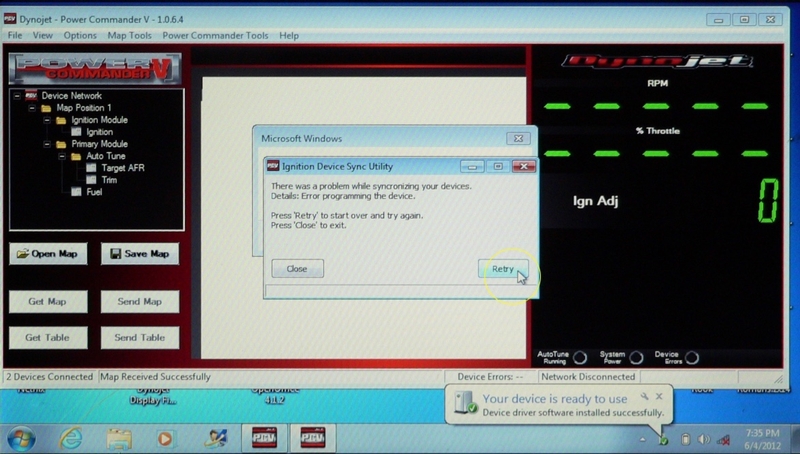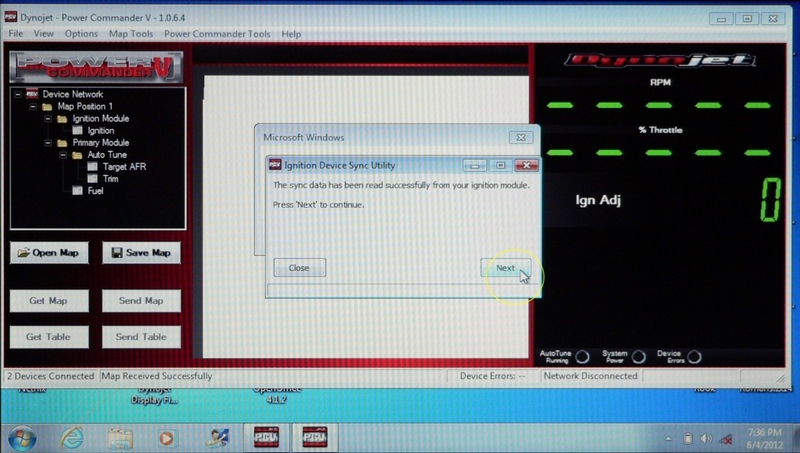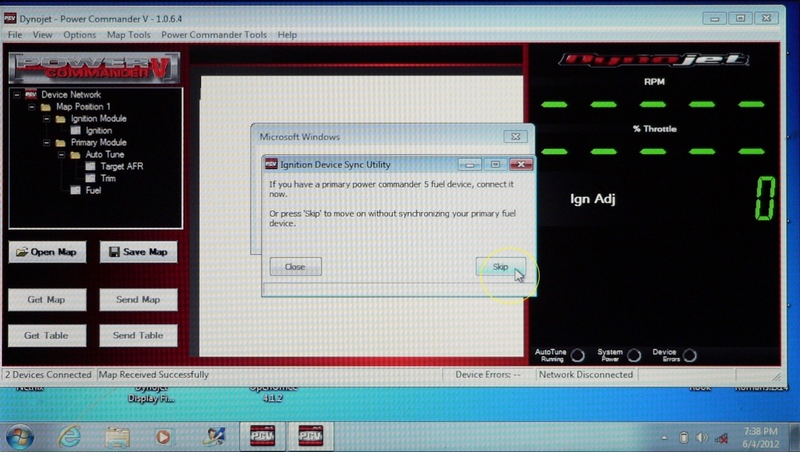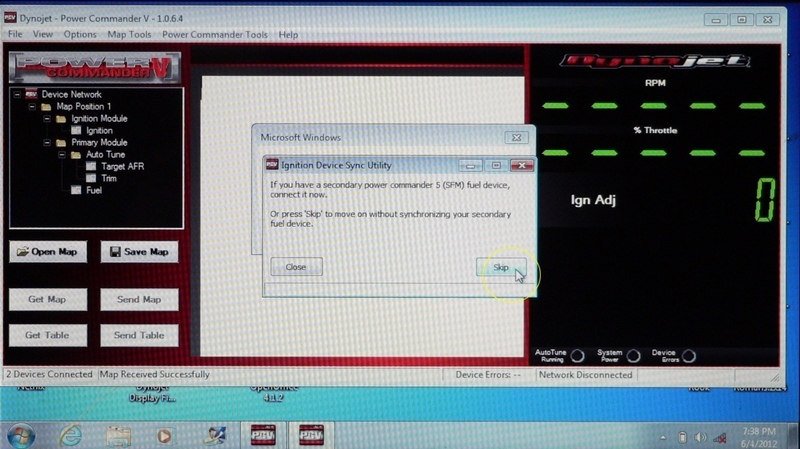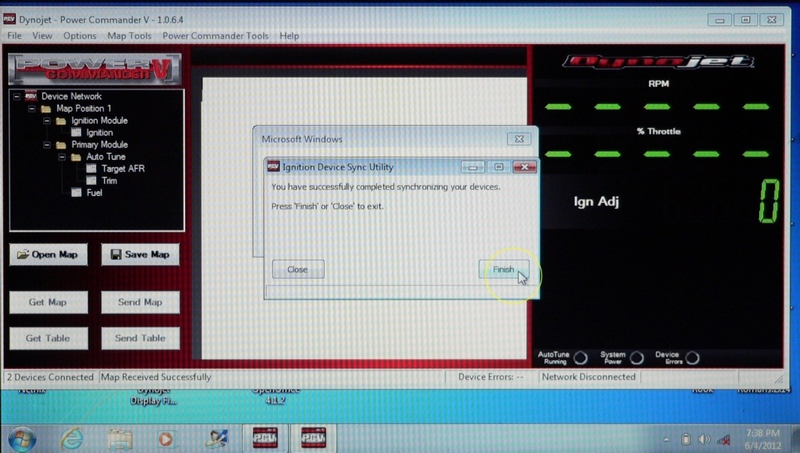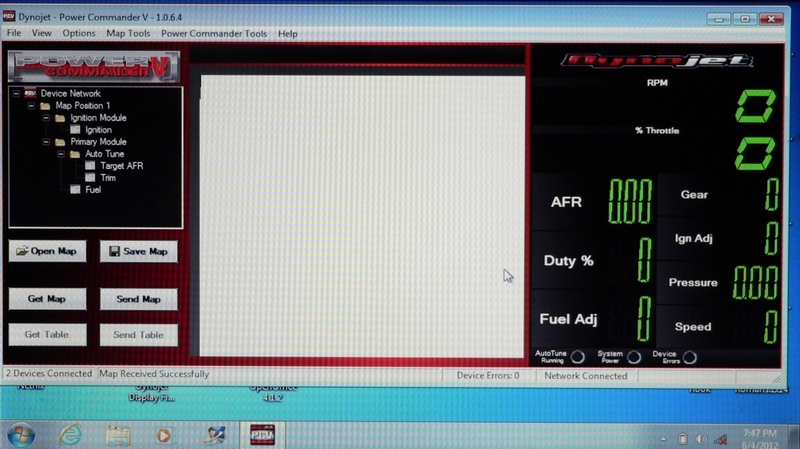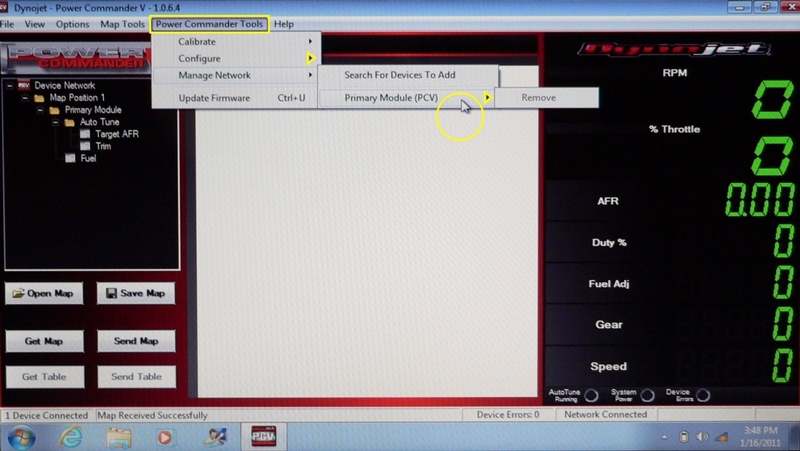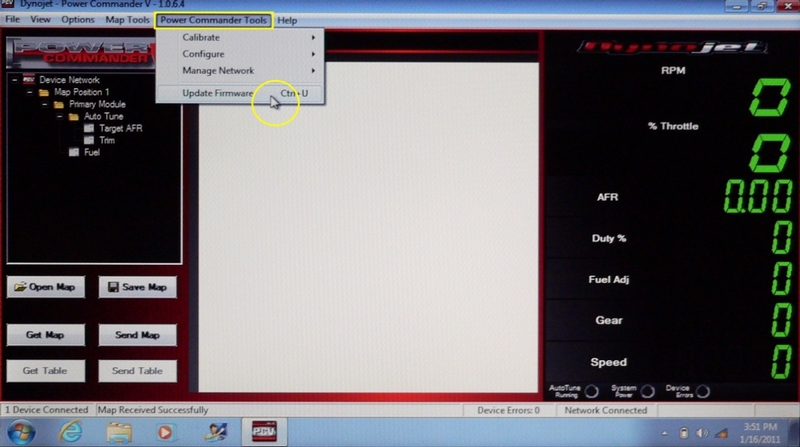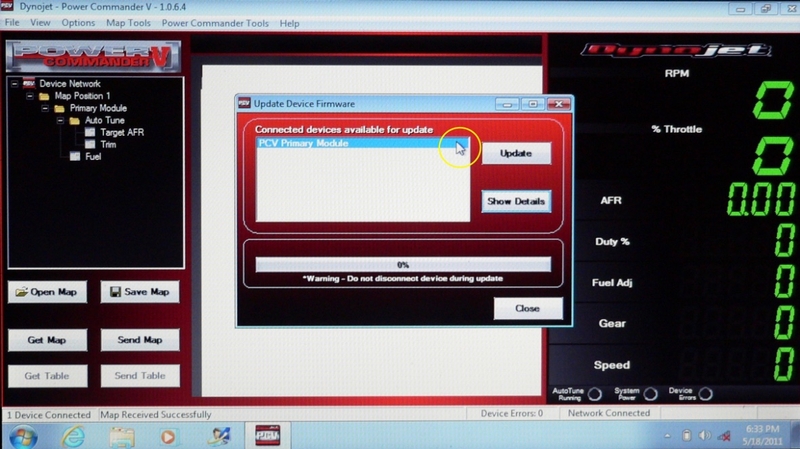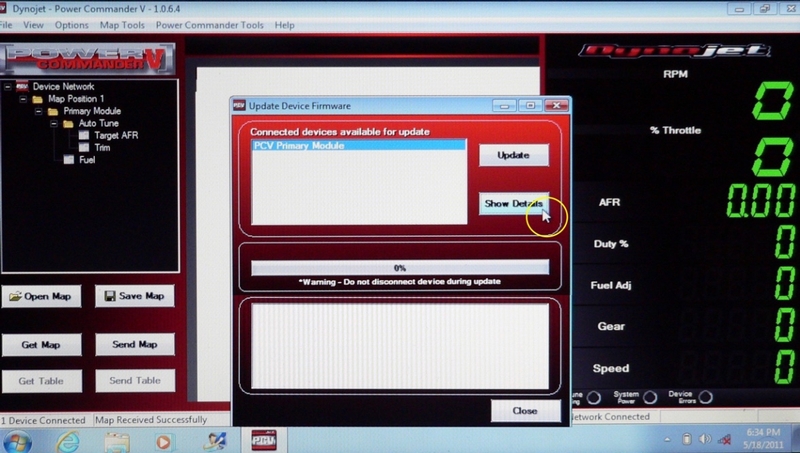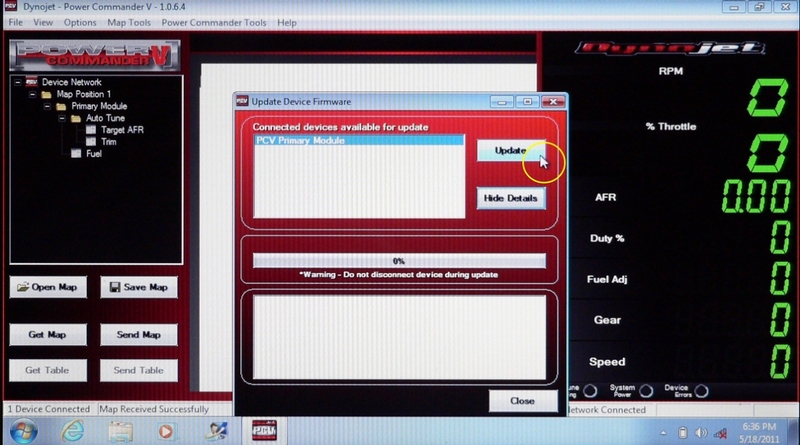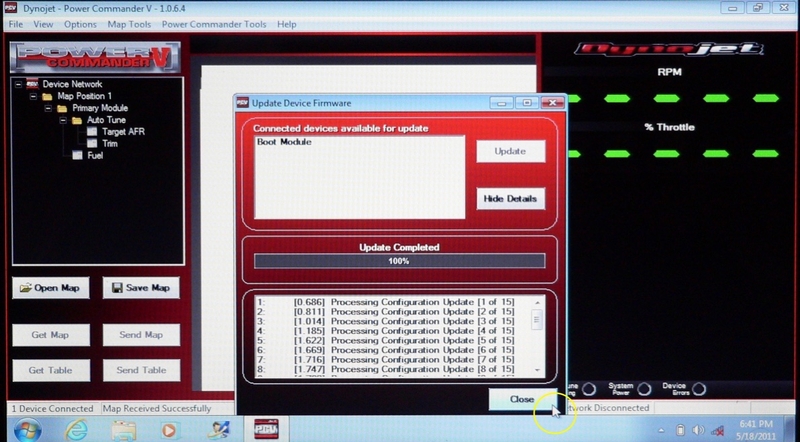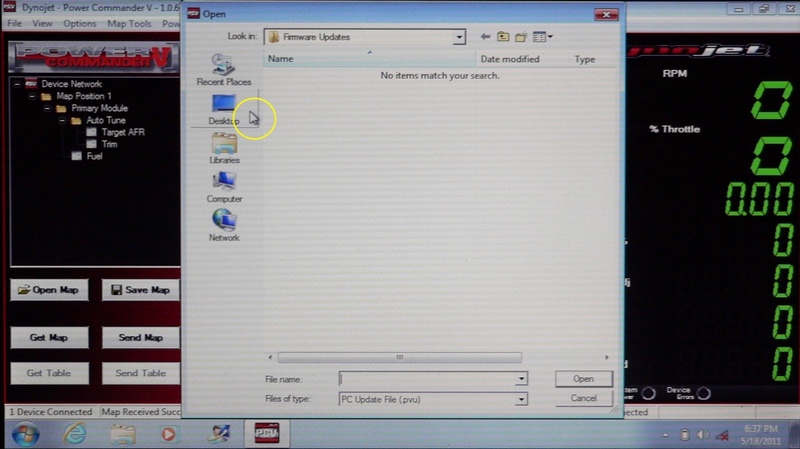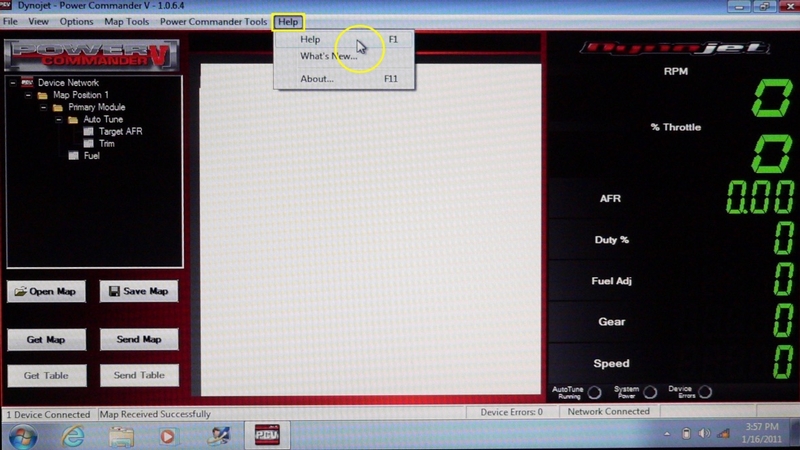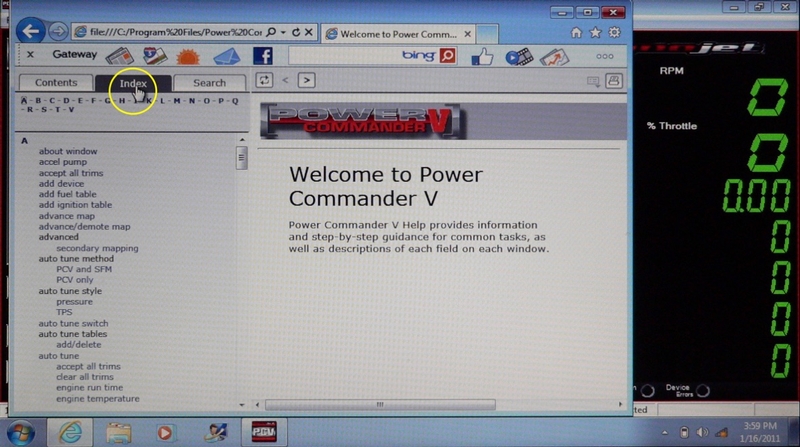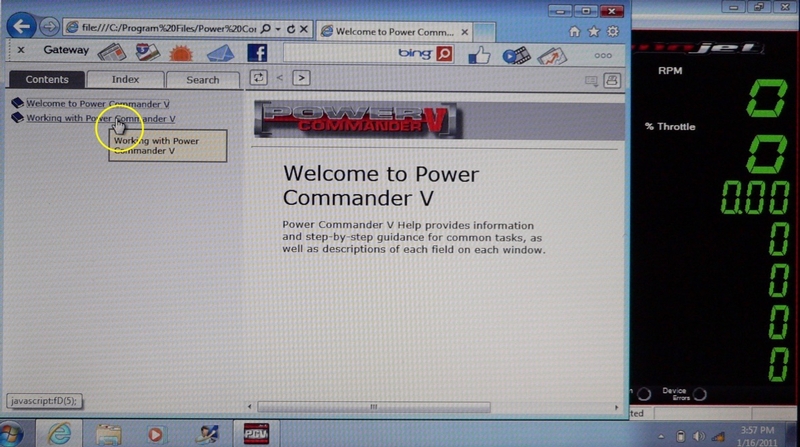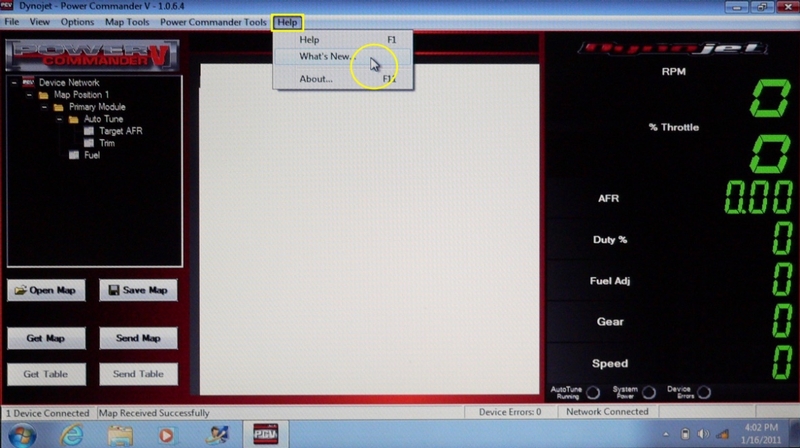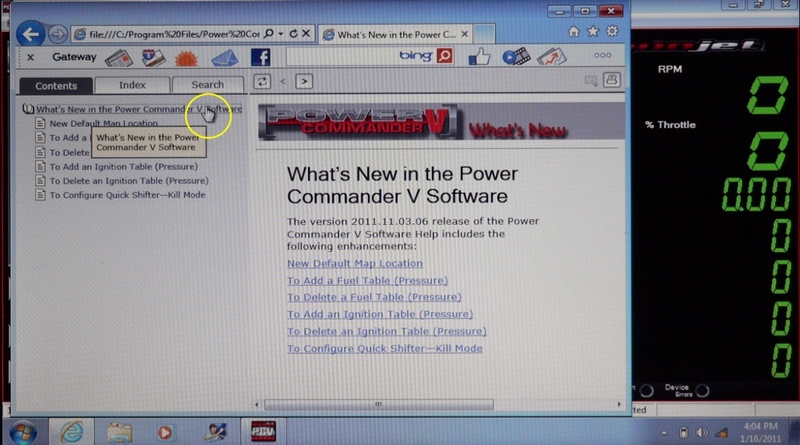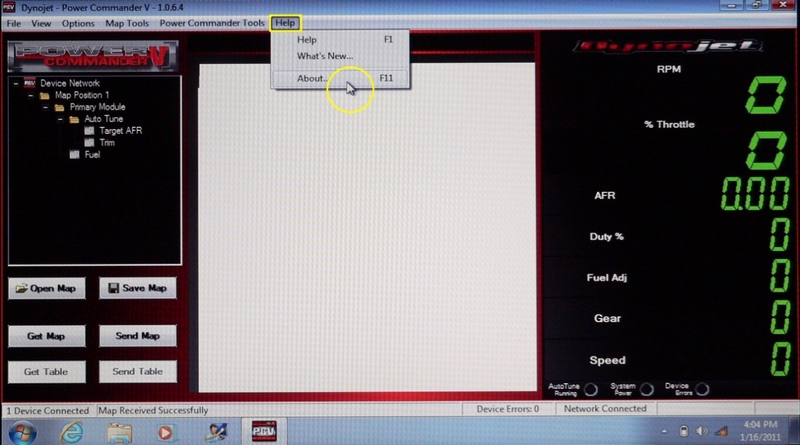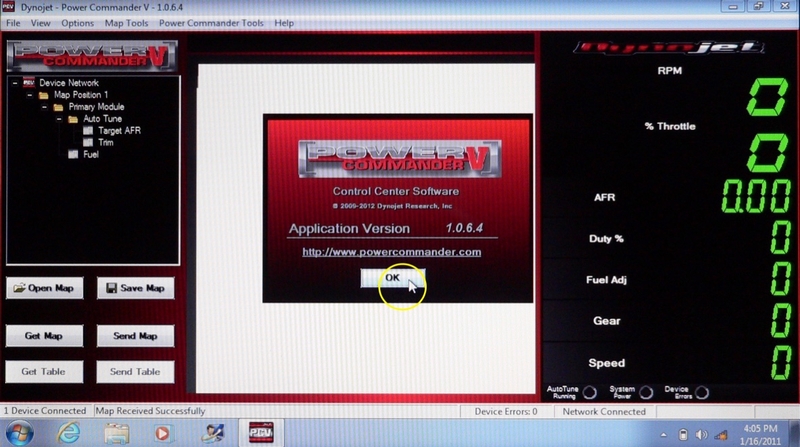How To Load Maps and Overview of Power Commander 5 v1.0.6.4
I will explain the purpose of all functions and displays of Power Commander 5 v1.0.6.4 in this tutorial. You may use this information to experiment and help acquaint yourself with the software. If you X out of selection boxes rather than clicking the OK button, the settings in your PCV will remain what they previously were. The steps that you should check and save changes if necessary are:
Step 23. Click Defaults > OK or select option(s) to create backup map files.
Step 27. TPS voltage and percentage calibration.
Step 36. Update firmware.
The process of loading maps is explained in detail but this tutorial is not meant to fully explain implementation of most other processes that may be executed with the software. I will address those processes in future tutorials where the auxiliary wiring, sensors and other devices required are also explained.
A laptop is the best computer to use PCV software with because a laptop is easy to bring to the bike. In some cases, you may want to carry the computer on the bike to make calibrations. A small laptop is best for this. I have a Gateway LT4010u notebook and it is the perfect size to velcro to the fuel tank cover while still being large enough to view and use while riding.
Downloading PCV Software To Your Computer
To download the most current version of Power Commander 5 software, go to powercommander.com
click the left hand picture of the race bike, ACCESS RACE READY, FUEL INJECTION MODULE SITE
from top menu, click DOWNLOADS
from listed items, click access downloads > Power Commander V
from listed items, find SOFTWARE, Power Commander V Software, 1.0.6.4
click file icon under Download
Retrieve file, Install Power Commander 5 v1.0.6.4.exe from your downloads and double click to begin the install to your PC computer (Power Commander software is not Mac compatible). I accepted all default settings clicking Continue in each box that came up and finally clicked Finish. There will be an Icon on the desktop to open the PC5 software.
Downloading Dynojet files is not difficult but you may use the following link for a more detailed description.
Power Commander 5 v 1.0.6.4 is the most current software as of 07-2016. This software will allow you to view and process data from Power Commander 5, Ignition Module for Power Commander 5 and Autotune-200 and other Dynojet devices in Power Commander 5 networks. If any of these devices require firmware updates, those can be downloaded in the same manner as the PC5 software.
Here is a very quick explanation of the software’s main displays and controls before explaining each in detail.
Menu Bar The light blue bar at the top of the screen is the main method of navigating the software. The menu bar contains headings for adjusting and selecting all features and for executing all tasks. Double clicking any heading in the menu bar will cause a dropdown menu to appear to navigate to more specific functions of the software.
Status Bar The grey bar along the bottom of the screen contains boxes that verify certain conditions exist such as, “1 Device Connected” or Map Received Successfully.”
Table Manager The black box below the Power Commander V logo displays all folders and files that are immediately available to the system. You may see more or less info in this box depending on the number of devices that are in your network and the number off features that are enabled.
Tool Panel The six buttons below the map box may be clicked to open, load and save maps and tables.
Table Window The large center box is where the map tables will be viewed.
Gauge Panel Various data channels are displayed on the right hand side of the screen below the Dynojet logo when the PCV is connected to the computer. RPM is the number of revolutions per minute the engine is currently turning at. % Throttle is the percentage the throttle is opened. AFR is the number of parts air that are currently mixing with one part of fuel. Duty % is the percentage of fuel injector capacity that is currently in use. Fuel Adj is the percentage of stock units of fuel that is currently being added or subtracted. Gear is the current gear position of the transmission. Speed is the the speed in mph that the wheel is currently turning. Depending on what devices and auxiliary sensors are in your network and how the PCV is configured, you may have more or fewer gauge displays than this.
Indicators There are three indicators below the gauge display, Auto Tune Running will light up when Auto Tune is sampling exhaust. System Power will light up any time the engine runs and Device Errors will light up when an error has occurred with a device in the network.
Status Bar The grey bar at the bottom of the software screen has several boxes to give alerts of what is happening with the system.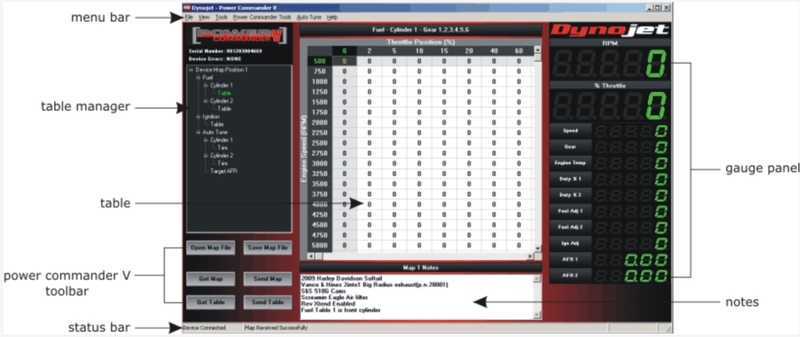
Accessing Map Files From Your Computer
You will need to have a PCV map file on your computer desktop to access it. You may get a map file from powercommander.com or ask for a map from a tuner. The computer does not need to be connected to the PCV yet but it may be if you wish.
1. Retrieve the map file you wish to load to the PCV from where the map file is stored on your computer. Place it on the desktop. The map file name must end in the extension .pvm in order for it to be accessed by the PCV software. If the file does not end in .pvm then you must edit this extension at the end of the file name. The icon will change to a Power Commander icon similar to the icon for the software.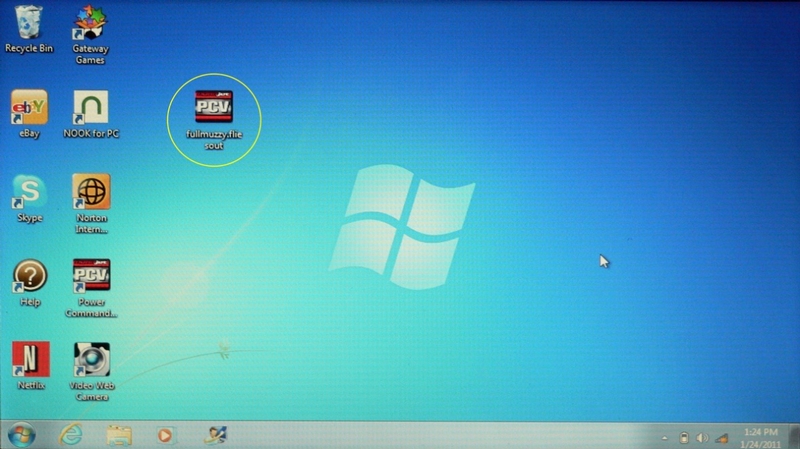
2. Double click on the PCV software icon to open the program.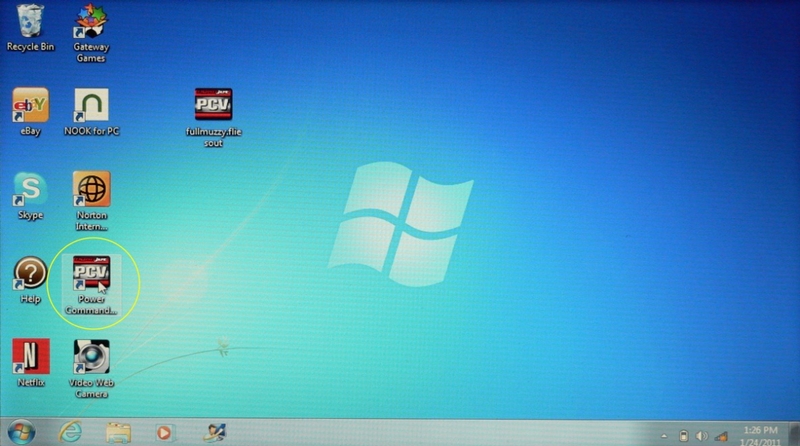
3. The PCV program will open. A Windows Confirm box may come up indicating that the default location for map storage has been changed. If you X out of it it will probably keep coming up or your maps will be sent to your C drive, only. Click the Yes button to have saved maps sent to your desktop where they will be easy to find and safely relocated for storage.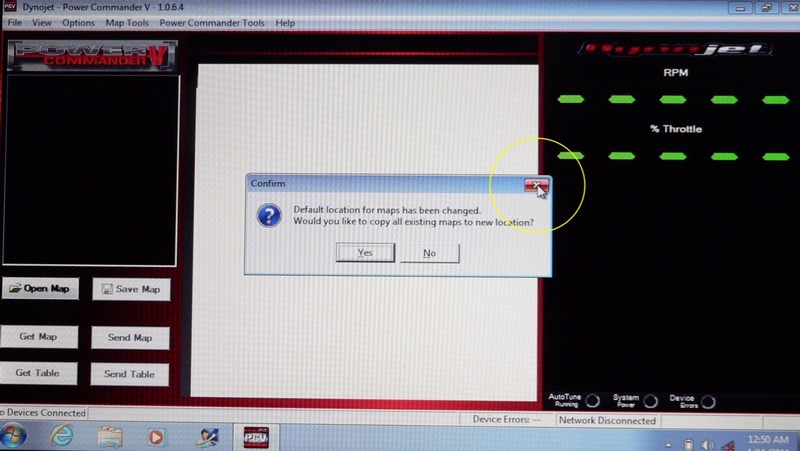
4. Click the Open Map button from, the Control Panel to access the map file you have stored on the desktop.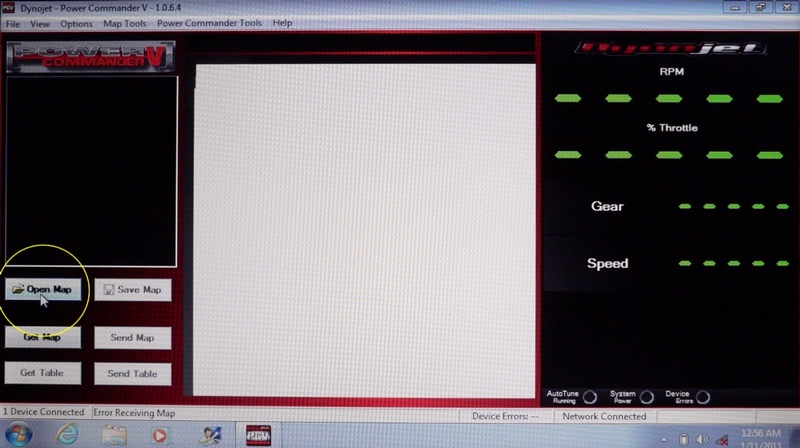
5. A Windows box called Open Map File will open. Click on the icon for the map file you wish to view. The file icon will become highlighted and the information will appear in the search boxes for File Name and Files of Type.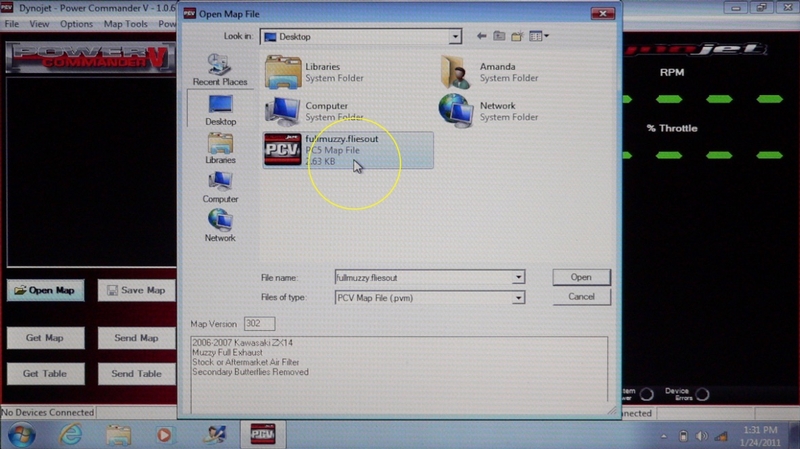
6. Click the Open button in the Open Map File box or click Cancel to close the Open Map File box without opening the selected map.
7. The Table Manager will display the expanded folders for the map. The Map folder is on top and is labeled whatever the opened map is named (in my case, fullmuzzy.fliesout.pvm). Within this folder is the Map Position1 folder. This folder contains the map for toggle switch position 1. The PCV can have a toggle switch connected to it to select between two maps stored in the PCV. If there was a map for toggle switch position 2, you would see a folder for that map as well. Within the Map Switch Position folder is the Primary Module folder. This folder is for the PCV. If there were other devices connected to the PCV, there would also be folders for them inside the Map Switch Position folder. Inside the Primary Module folder is the Fuel folder which holds the fuel map you wish to view.
You may reduce the display of folders by clicking the - symbol to the left of the folder. The - symbol will become a + which can be clicked to expand the display again.
You will notice that the Save Map button in the Control Panel is now activated as well as the Open Map button.
Click the Fuel icon in the Table Manager to view the fuel table for the map you have open.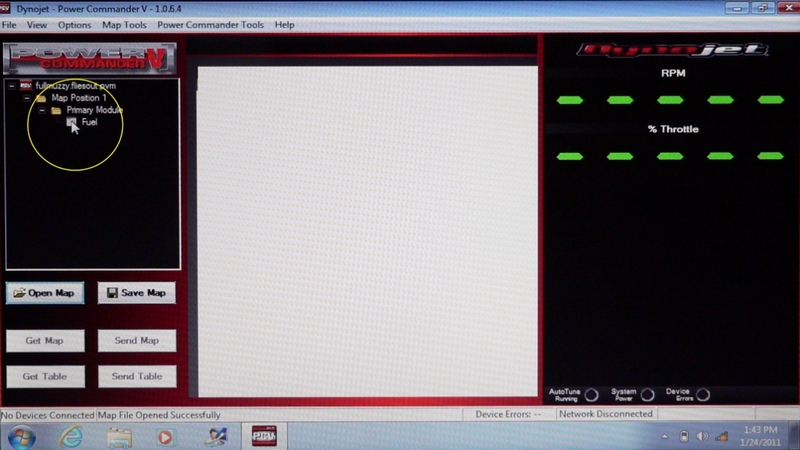
8. The fuel table will open in the Table Window at the center of the PCV software display. Above the fuel table is a notation indicating that this table is for map switch position 1 fuel map cylinders 1, 2, 3 and 4 and for gears 1 through 6. It is possible to have separate maps for each cylinder and each gear when advanced settings are used.
The fuel table is a matrix of throttle position percentage columns and engine rpm rows. Each cell of the matrix has a number that indicates the percentage of stock units of fuel that the map adds or subtracts from the units in the stock fuel table in the ECU (see step 10 of AFR TUNING WITH AUTOTUNE for more info on difference between stock fuel mapping and Dynojet fuel mapping). If there is a minus sign (-) with the number, it indicates the percentage of the stock fueling subtracted (i.e. -10 means 10% of stock fuel is subtracted). If there is just a number, it indicates the percentage of stock fueling that is added (i.e. 10 means 10% of stock fuel is added). If there is a 0 in the cell, that means the fueling in the ECU is unchanged. View the fuel table to understand the following example. The fullmuzzy.fliesout map subtracts 3% of stock fueling at 1500 rpm when the throttle is 2 percent open (the number, -3 is in the 1500 rpm/2 tp cell). At 5000 rpm and 40 percent throttle, the map adds 10% of the stock fueling (10 is in the 5000 rpm/40 tp cell).
The entire fuel table may be viewed by using the up/down arrows to or clicking in the scrolling bar to the right of the Table Window. The map could also be saved to your computer by clicking the Save Map button in the Control Panel but this is not necessary because the map is already on the desktop.
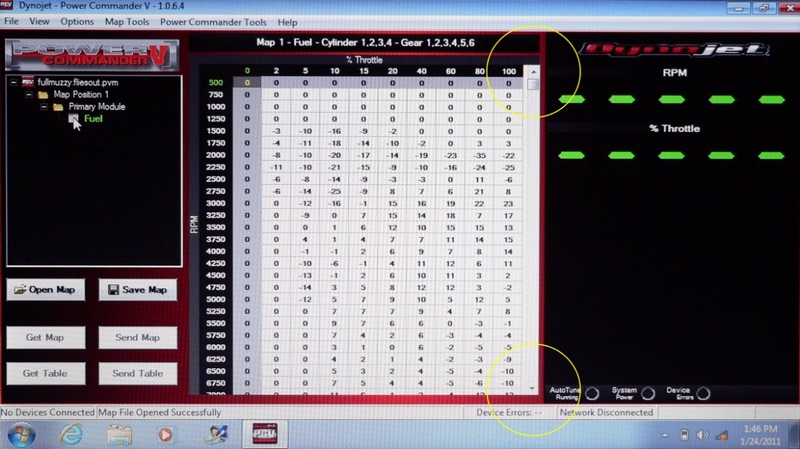
Go to File in the Menu Bar and click Close Map File (see step 20) to close the map file you currently have opened.
Loading Maps
9. In order to load maps and for all other functions of the software to be activated, the software must interact with the PCV. Pull out rubber plug and connect the usb cable to the PCV. Plug the other end of the cable into the usb port on your computer. The power indicator light on the PCV will remain lit with the PCV powered off of the computer.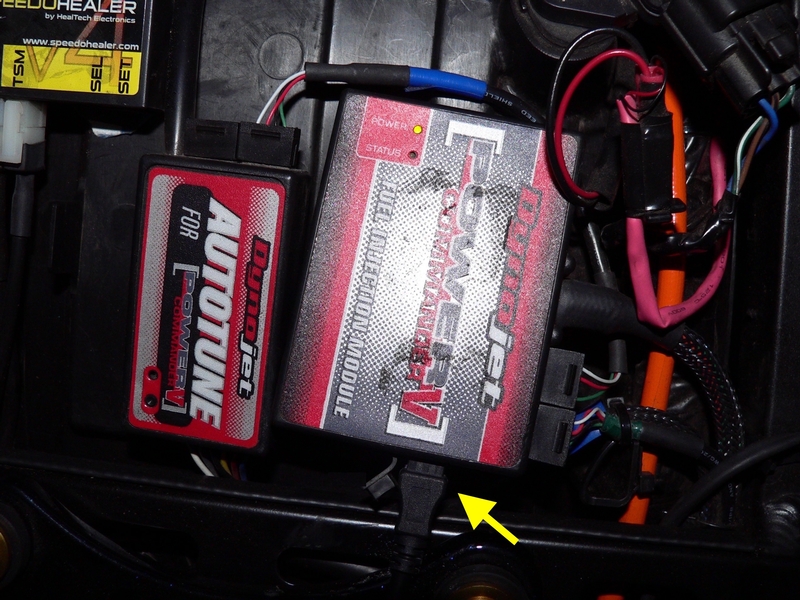
10. A Windows message box will pop up indicating a device driver is being automatically installed to your computer. This will take about one minute.
11. X out of the box that appears when the device driver has been installed from the PCV to your computer. The Get Map button in the Control Panel will be activated when the computer is linked to the PCV. There will be additional gauge displays in the Gauge Panel on the right of the screen.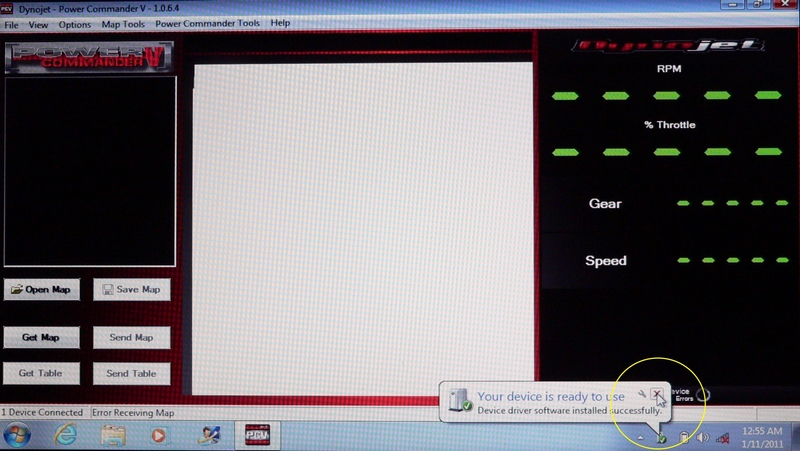
12. Minimize the PCV software to view the desktop. If you see the box shown in the picture below, maximize the PCV software and close it. Click Restart Now in the Microsoft Windows box to apply changes required by the installation of the device driver. Any time you find this box on your desktop after exiting the PCV software, you should click Restart Now before shutting down the computer to avoid unnecessary reboots when you turn your computer back on.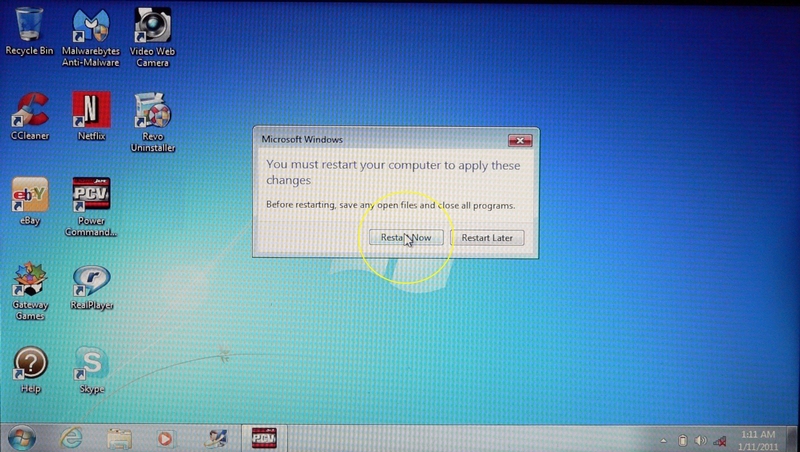
13. When the computer restarts, open the PCV software as described in steps 2 and 3. The dashes in the RPM, % Throttle, Gear and Speed displays in the Gauge Panel will now be 0s and there will be a display for Duty %. If Autotune is connected to the PCV, there will also be an AFR and Fuel adjustment display. If there is a map stored in the Power Commander, it may automatically open identified as Device Network in the map box on the left. 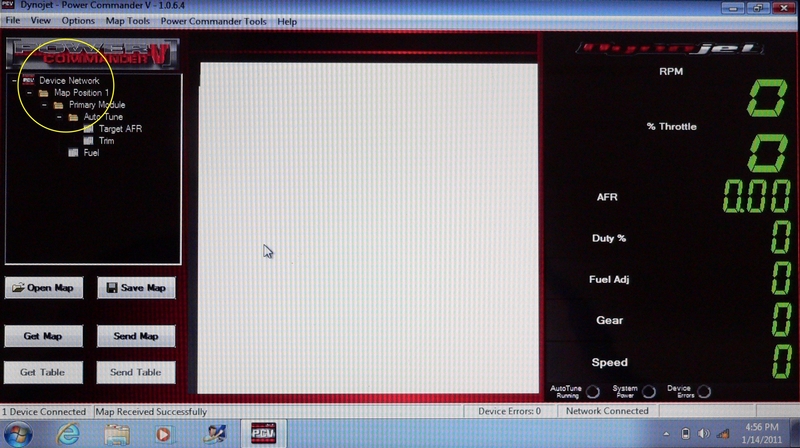
14. Click the Get Map button in the Control Panel. This will only open the map that is stored in the Power Commander and the map file will always be identified as Device Network. Get Map will not allow you to access maps stored on your computer. If you had a map from your computer open for viewing or editing, it would close and the stored map would open when you click Get Map.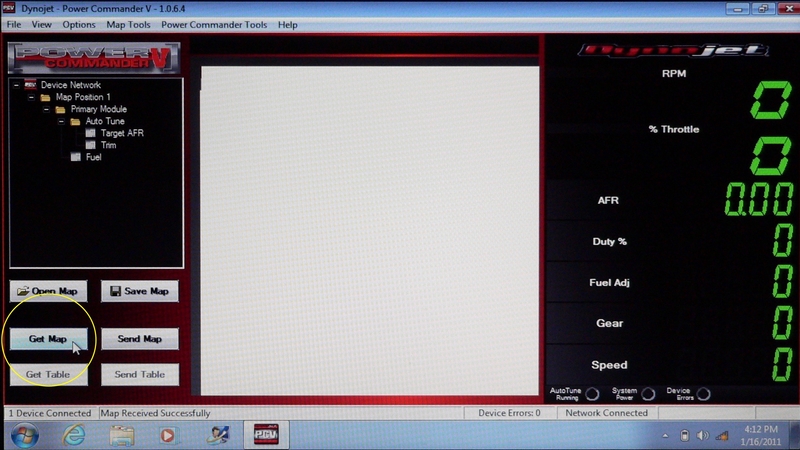
15. Putting a new map into the PCV will erase the old map. If you are going to change the map stored in your PCV, it is very important that you save a copy of the previous one to your desktop first. The default settings of Map Tools should automatically do this for you (see step 23) but I suggest getting in the habit of saving replaced maps manually and checking that they are saved before replacing it.
Click Save Map in the Control Panel.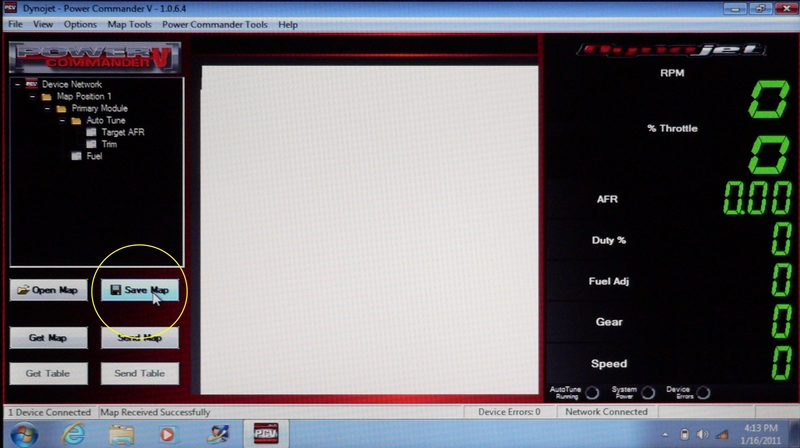
16. The Windows Save As box will open showing all maps already on the desktop. I have the Muzzy full system/flies out map on my desktop and waiting to be loaded after I save the map that is in the PCV. Click the File name text box and enter whatever you wish to name the current map file. I have named the current map m4slips.pvm
Click the Save button and the map in the PCV is saved to the desktop.
X out of the Save as box.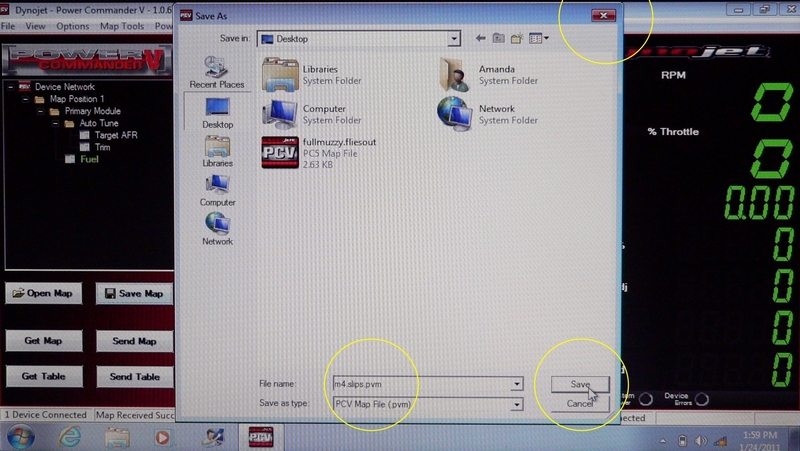
17. Minimize the PCV software to view the desktop. If the map file in the PCV is visible on the desktop, it is now saved. The map you wish to load to the PCV is still located on the desktop as well.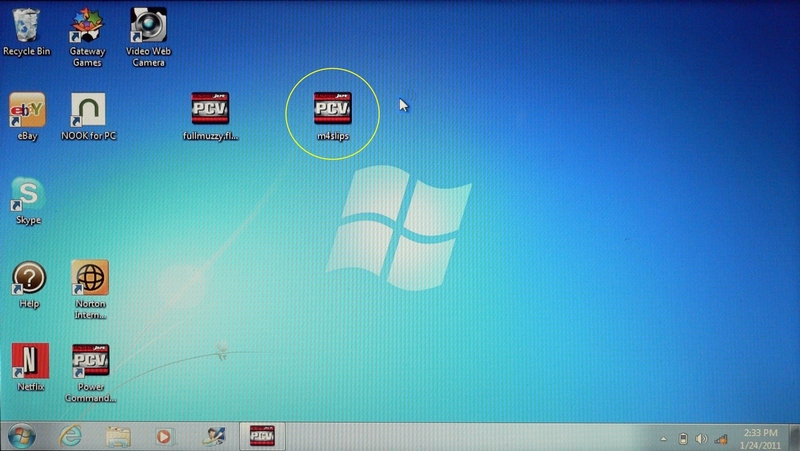
Un-minimize the PCV software again.
18. Follow steps 4 through 7 for opening the map that you wish to load to the PCV from the desktop. In this case, it is fullmuzzy.fliesout.pvm The new map opens and its folders will be expanded in the Table Manager of the PCV software. In the picture below, you also see a folder for Auto Tune because I have Auto Tune connected to my PCV.
Follow step 8 to view the fuel table of the new map.
The new map is opened in the PCV software but it is not yet loaded to the PCV. The current map is saved on the desktop but it remains loaded in the PCV until the new map is loaded. You may click on the Get Map button to view the current map. You may also click Open Map to compare the new map or any other map you have on the desktop.
19. With the current map saved and the new map opened, Click Send Map in the Control Panel. This will load the map that is opened to the PCV. The new map is loaded to and the old map is erased from the PCV. The new map folders will appear in the Table Manager. The map currently loaded to the PCV is always labeled, Device Network. 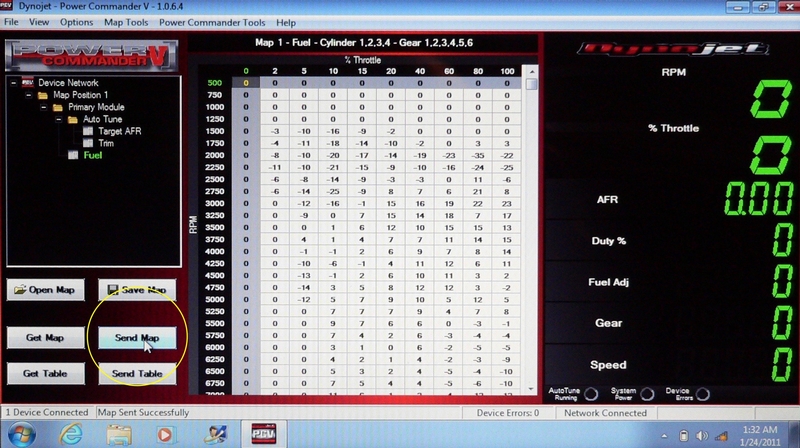
The Get Table button in the Control Panel is used to bring a table from the PCV to the laptop. The Send Table button sends a single table to the PCV from the laptop rather than the entire map. The use of these buttons as well as information on related features of the PCV are covered in AFR Tuning with Auto Tune.
To briefly recap:
To view the map currently in the PCV: Get Map > Fuel
To view a map the is on the desktop: Open Map > select the map icon > Open > Fuel
To save the map currently in the PCV: Get Map > Save Map > name the map > Save
To load a new map to the PCV: Open Map > select the map icon > Open > Send Map
X out of the PCV software.
Functions and Settings of Power Commander 5 v 1.0.6.4
The computer must be connected to the PCV in order to activate all functions of the software. Follow steps 9 through 13 to open the software. The device driver may need to be installed again (steps 10, 11 and 12).
20. Go to the Menu Bar of the PCV software and click File. A menu will drop down with 6 selections. Click Open Recent to open a list of maps that have been recently opened. If you double click on a map from the Recently Opened list, you can navigate to that map in the same manner as you did when you clicked the Open Map button in steps 4-7. You may remove all recently viewed maps from the list by clicking Clear All Recent Files. Open Map, Get Map and Save Map do exactly the same thing as the buttons in the Control Panel with those names (steps 4 through 7, step 14 and steps 15 through 17). Clicking Import PC3USB Map (.djm) which will reformat a PC3 map and open it for use in PCV. Clicking Close Map will close the map file currently open. Clicking Exit will close the PCV software. 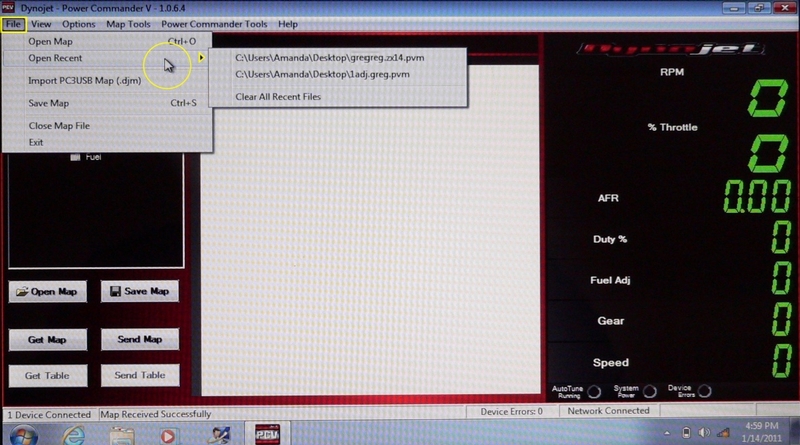
21. Next go to View in the Menu Bar. The menu that open contains three selections.
Cick on Show Map Notes to open a text box at the bottom of the map table window. When this feature is activated with ta map opened, you may see previous notes about the map and you can type your own notes. Click Hide Map Notes.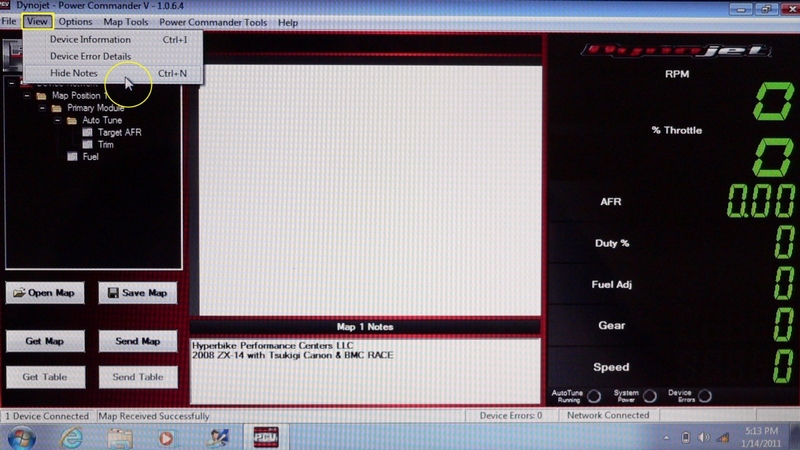
Click on Device Information to view an info box of data and specs about the Power Commander V module in your bike. X out of the info box.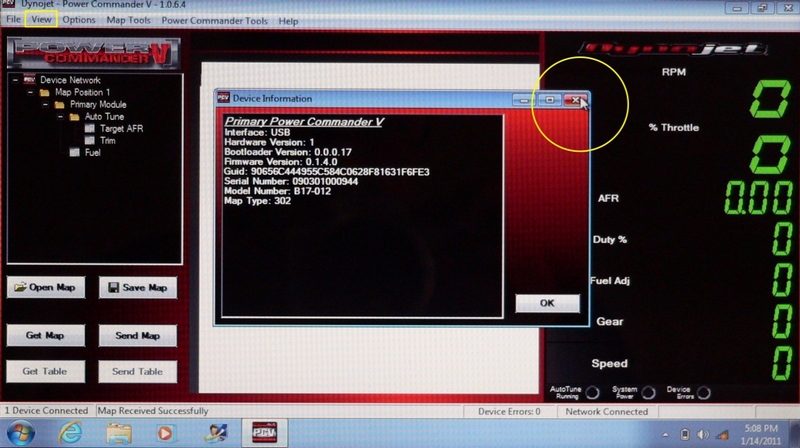
Click on View in the Menu Bar and click on Device Error Details to view info about errors that have occurred with your PCV. X out of the Device Errors information box.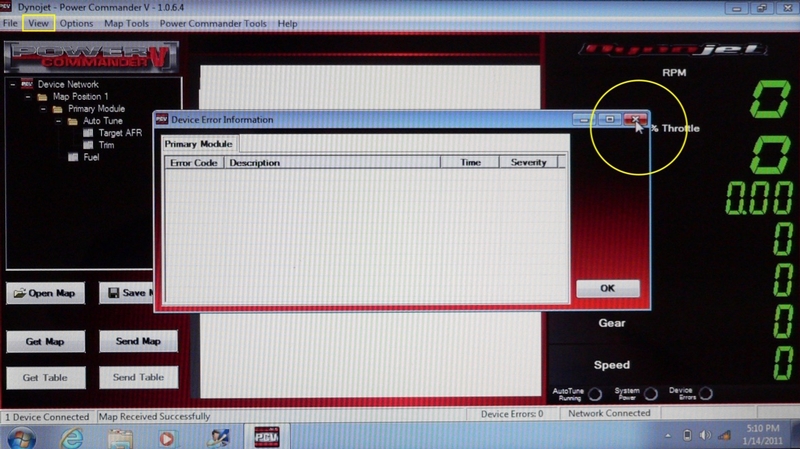
22. Click Options in the Menu Bar. Click Environment Options in the menu that appears.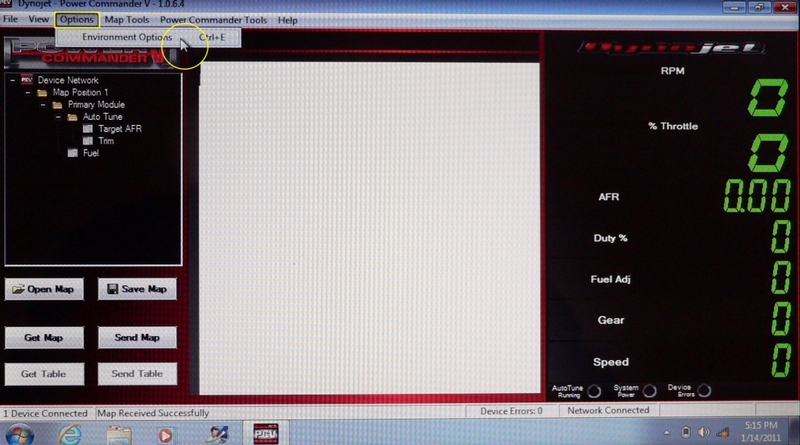
23. A box will appear with various options for the Power Commander functions.
Retrieve device map upon connection will make the map in the PCV open automatically as soon as the power commander is connected to the computer with the PCV software running.
Show ignition tables even if Power Commander is not ignition capable will allow an ordinary PCV to display the ignition folder in the Table Manager and view ignition tables in the Table Window as though it was a PCV+Ignition (PCV+Ignition is a more recent product than the PC5 I own) or if there is a Dynojet Ignition Module in the network. The ignition table will contain all zeroes if the The PCV network is not ignition capable.
Show Auto tune tables even if Power Commander is not auto tune enabled will allow Target AFR and Trim tables to be selected in the Table Manager so that they can be viewed in the Table Window even if there is no Auto Tune connected and enabled (my bike has Auto Tune so you see the selections in the Table Manager). If Auto Tune is not connected and enabled, the target AFR table could be viewed but trims cannot be generated so the trim table will be filled with zeroes.
**To ensure that maps are not accidentally deleted, I recommend that one of the following two preferences be enabled.
Create backup map file upon device connection automatically copies the map in the PCV to your documents folder as soon as the PCV is connected to the computer with the PCV software running.
Create backup map file upon sending map to device automatically copies the map in the PCV to your documents folder as soon as a map is sent to replace it.
Table Cell Tracer Enabled highlights the map cell that the current rpm and throttle position occupy. This is so that you can easily determine in real time what point in the map the engine is running. Duration (sec) determines the length of time cell tracer will be visible.
Software Preferences > Manually select gauge channels will allow you to select only the gauges that you want to see displayed in the gauge panel. Table row height determines the size of the cells viewed in the Table Window. The Small cell selection allows the largest portion of the table to be visible without scrolling.
Click Defaults and then select Small for Table row height. Click OK.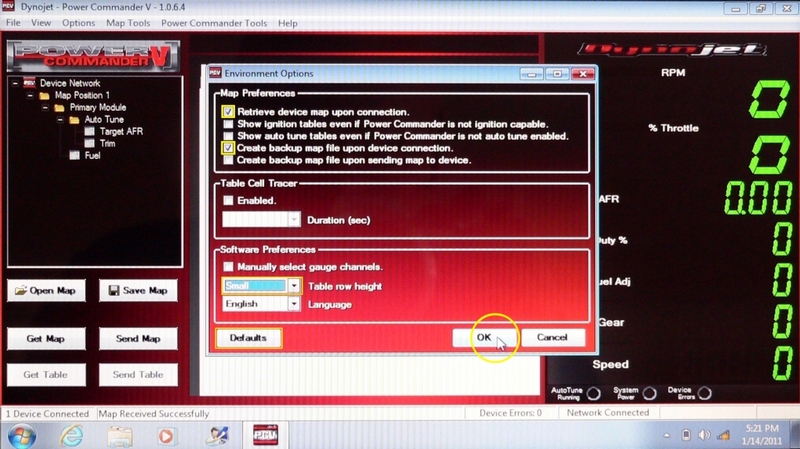
24. Click on Map Tools in the Menu Bar of the PCV software to view a menu of three selections. The first, Advance/Demote Map will open a box where map viewing options of various levels of complexity can be selected.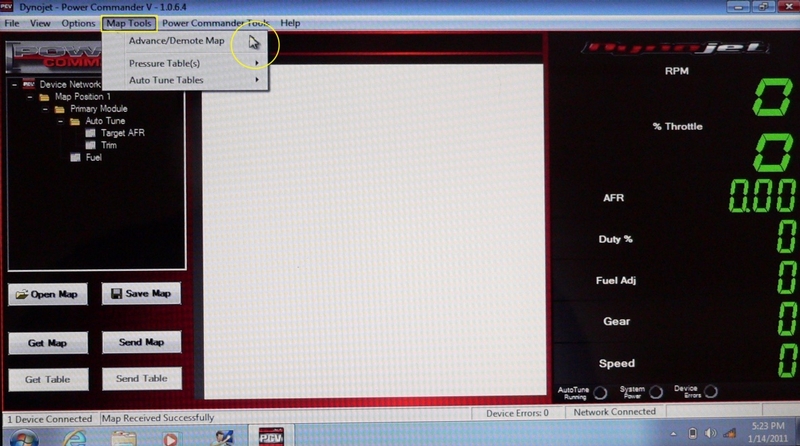
Click the dropdown menu pointer of the first selection, RPM Resolution to select map tables that have rpm cells in increments of 250 rpm or 500 rpm.
Click 250.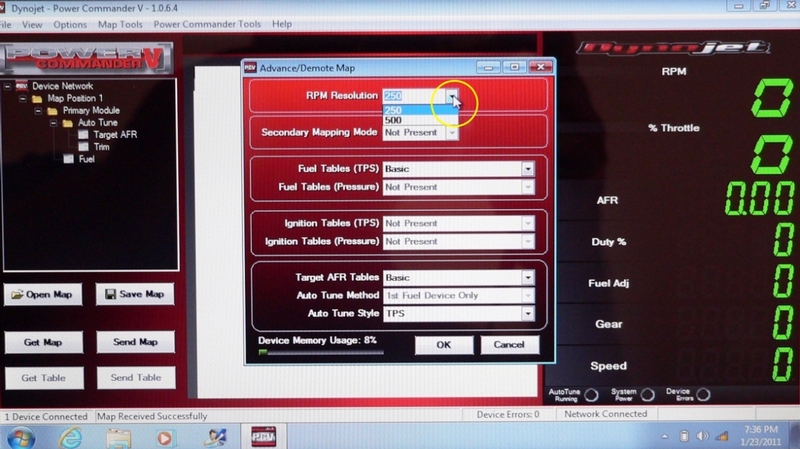
The second selection, Secondary Mapping Mode enables tables from a secondary fuel module to be viewed and/or edited. A secondary fuel module is for engines with eight injectors such as the Hayabusa. Secondary Mapping Mode is Not Present because my PC5 did not have the firmware update at the time a making this tutorial.
Click the dropdown menu pointer for Fuel Tables (TPS) to select from four options. Basic will allow one fuel table for all cylinders and all gears to be opened and viewed as shown in steps 7 and 8. Cylinder Advanced will create folders in the Table Manager display for separate mapping of each cylinder. Gear Advanced will create folders in the Table Manager display for separate mapping of each gear. Cylinder and Gear Advanced will create folders in the Table Manager display for separate mapping of each cylinder and each gear.
Click Basic.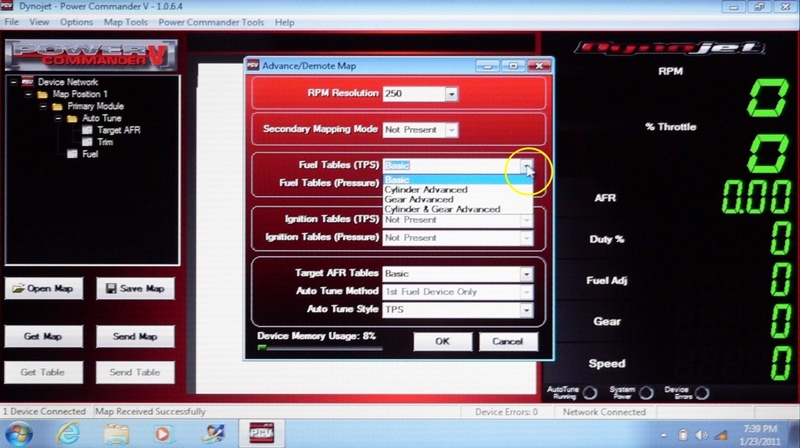
The Fuel Tables (Pressure) is Not Present because my PC5 did not have the firmware update at the time a making this tutorial. Also, this function requires a mass air pressure sensor and auxiliary wiring to be connected to the PCV. Mass air pressure input is useful for tuning turbo applications. I assume the fuel table selections are the same for Pressure as they are for TPS.
Ignition Tables (TPS) is Not Present because my PC5 did not have the firmware update at the time a making this tutorial. These selections are for PCV+Ignition modules or when an Ignition Module when it is connected to an ordinary PCV. The selections for Ignition Tables are the same as they are for Fuel Tables (per cylinder, per gear or per cylinder and gear).
Ignition Tables (Pressure) is Not Present because my PC5 did not have the firmware update at the time a making this tutorial. This feature has the same selections for mapping per cylinder and gear as Ignition Tables (TPS) but the PCV must be equipped with a mass air pressure sensor which is normally only done for turbo bikes.
Target AFR Tables allows separate AFR tables to be created for different gears and cylinders. Basic is the only selection available with the settings I have previously recommended.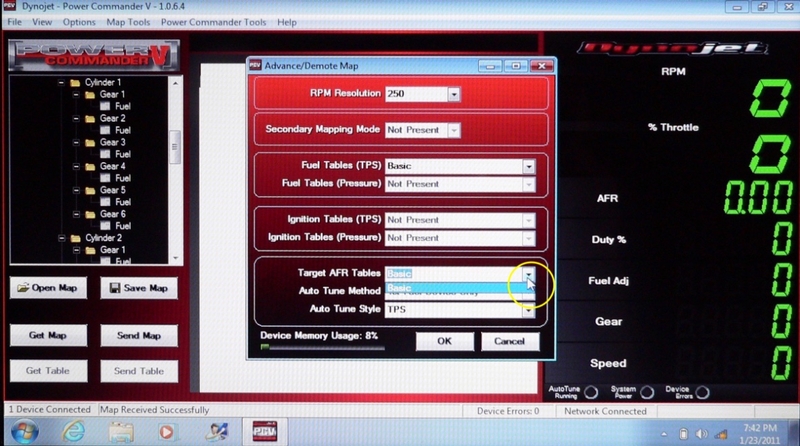
The Auto Tune Method selections would apply to networks with a secondary module for eight injectors. This feature is Not Present because my PC5 did not have the firmware update at the time a making this tutorial.
* Last updated by: Rook on 3/2/2018 @ 7:43 PM *

